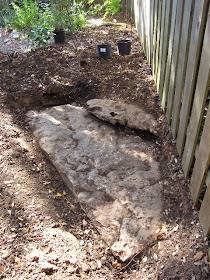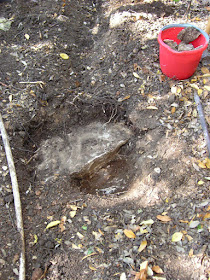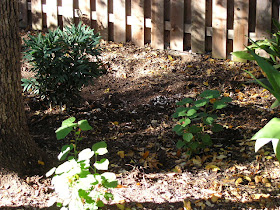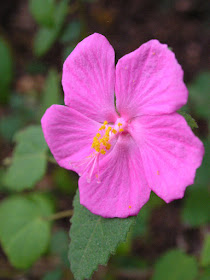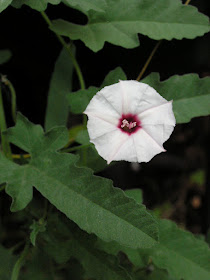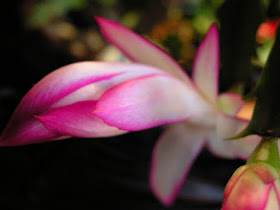My first two attempts at planting my last Evergreen Sumac (Rhus virens) met with enough limestone that I had to make other plans: the first led to a Chinese Mahonia (Mahonia fortunei) taking the proposed locale, the second is still being pondered but will likely end with Cast Iron Plants.
Then came my third attempt. And, of course, I discovered rock.
Fortunately my initial excavation had uncovered an edge, so I kept digging outward to find the other sides. And digging...and digging...and digging. Holy moly!
I thought I had unearthed large stones before in my garden, but now I realized they were just the appetizers. This may well be the main course. I finally found a second edge but, by this point, the stone measured nearly nine feet across the front.
And then, at the back, I discovered yet another thinner layer of rock on top.
Further digging allowed me to better define it's size - about three foot across the front.
Eventually I found the larger rock's other edge - but only to discover another rock laying immediately adjacent to it.
I'm beginning to be amazed that I've been able to plant anything back here - and worried that, even though I dug pretty deep when planting, the plants may still be sitting in soil that is too shallow.
Obviously my entire plans for the area are undergoing a massive rethink. Everything is on hold as I continue to excavate my limestone layers.
Wednesday, November 28, 2012
Monday, November 26, 2012
Joe Pye Shrub - Lots of Late Blooms
This year, my Joe Pye Shrub (Eupatorium viburnoides) has really been blooming.
The clusters of flowers are made up of numerous tiny blossoms that are quite attractive when viewed close up.
It has provided plenty of late fall nectar for the insects that are still out and about in our warmer-than-usual temperatures.
The shrub itself likely needed one more shearing to keep it more compact and less leggy, but some late sprouts shot up and got away from me. Several flower clusters have opened but others are still developing - so hopefully the show will continue a while.
The clusters of flowers are made up of numerous tiny blossoms that are quite attractive when viewed close up.
It has provided plenty of late fall nectar for the insects that are still out and about in our warmer-than-usual temperatures.
The shrub itself likely needed one more shearing to keep it more compact and less leggy, but some late sprouts shot up and got away from me. Several flower clusters have opened but others are still developing - so hopefully the show will continue a while.
Saturday, November 24, 2012
More Plants In The Ground
Planted a couple of Kaleidoscope Abelia (Abelia x grandiflora 'Kaleidoscope') into specific spots in my garden. The one near my pond required the removal of an Anthony Waterer Spirea (Spiraea x bumalda 'Anthony Waterer') which has survived but hasn't really thrived.
The second was planted near my Banana Shrub (Michelia figo).
The two should fill in nicely and hopefully add a little bit of color towards the back of those beds.
I also planted up a couple of pots with Pansies (Viola tricolor) - I didn't note the varieties (grumble).
All this planting led me to transplant my two Anthony Waterer Spirea from the backyard garden or pots to the front yard border garden. Hopefully they'll get a bit more sun in the new location and will help fill in for the drought-struggling Autumn Ferns (which I will likely move to the even shadier backyard gardens).
I was also able to get my last two Pam's Pink Turk's Cap (Malvaviscus drummondii 'Pam Puryear') into the ground. Though about the half the size of the previously planted ones, they should grow nicely next spring.
Most of these locations had some rock, but nothing prepared me for when I tried to plant my last remaining Evergreen Sumac in yet another location. But I'll post about that still-ongoing adventure later.
 |
| Before |
 |
| After |
The second was planted near my Banana Shrub (Michelia figo).
 |
| Before |
 |
| After |
The two should fill in nicely and hopefully add a little bit of color towards the back of those beds.
I also planted up a couple of pots with Pansies (Viola tricolor) - I didn't note the varieties (grumble).
All this planting led me to transplant my two Anthony Waterer Spirea from the backyard garden or pots to the front yard border garden. Hopefully they'll get a bit more sun in the new location and will help fill in for the drought-struggling Autumn Ferns (which I will likely move to the even shadier backyard gardens).
 |
| Before |
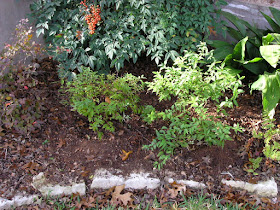 |
| After |
I was also able to get my last two Pam's Pink Turk's Cap (Malvaviscus drummondii 'Pam Puryear') into the ground. Though about the half the size of the previously planted ones, they should grow nicely next spring.
Most of these locations had some rock, but nothing prepared me for when I tried to plant my last remaining Evergreen Sumac in yet another location. But I'll post about that still-ongoing adventure later.
Monday, November 19, 2012
Planting: Gardener vs. Rock (Part 2)
Last week, I had planned on planting my second Evergreen Sumac (Rhus virens) in this spot to accompany the one I planted a couple of weeks ago. That time I was able to slowly pound, cuss and fracture my way through the limestone. But not this time.
Even though I immediately discovered an edge and moved the sprinkler system line, I was never able to get this rock to budge. There was no way the roots of the Evergreen Sumac would be able to grow to their needed depth. I considered planting a Chinese Mahonia (Mahonia fortunei) here instead, but additional digging near the edge exposed an even deeper layer of rock (the tip of the trowel rests upon it). Repeated blows from a sledgehammer and rock bar made little impact.
So I abandoned that site and instead moved the Chinese Mahonia over to the spot where I had planned to plant another Pam's Pink Turk's Cap (Malvaviscus drummondii 'Pam Puryear'). I will likely plant a couple more Pam's Pink Turk's Cap encircling the Chinese Mahonia - with one being farther back near my original rock-lined pit.
I am hoping that the evergreen Mahonias will make a nice backdrop to the two planted and two incoming Turk's Caps (especially since the Turk's Caps will lose their leaves in the winter). Will likely also extend my Cast Iron Plants (Aspidistra elatior) further along the fence to provide additional year-round greenery.
This morning, I picked this spot to plant another Rattlesnake Agave (Manfreda maculosa). I wanted to start here because I hoped it would be the least rocky location (the surface rocks were actually placed there by me - I got to do something with 'em after digging 'em up!)
Though there was a rock (grumble), it wasn't too difficult to remove. And the Rattlesnake Agave fits in nicely and will hopefully multiply as has my original planting.
Continuing to plant along the back of my garden, I prepared myself for substantial rocky discoveries. Sadly, I was not disappointed. I wanted to plant two of a planned four Gold Dust Plants (Aucuba japonica 'Variegata') here. The first hole required significant effort - so much so that I went on the the second spot to see if I could fair any better. It also had a considerable limestone presence, but at least they were of a size that, with lots of effort and rock bar torque, I could slowly pry them out of the soil.
Returning to the original spot, I removed some tree roots, then applied sledgehammer and rock bar to the stone. Over time, I was able to finally develop some cracks and pry out larger and larger chunks until I eventually broke through to the soil underneath.
I envision some large plants along the fence (possibly some variety of Oakleaf Hydrangeas) with the evergreen Aucubas providing winter foliage.
Even though I immediately discovered an edge and moved the sprinkler system line, I was never able to get this rock to budge. There was no way the roots of the Evergreen Sumac would be able to grow to their needed depth. I considered planting a Chinese Mahonia (Mahonia fortunei) here instead, but additional digging near the edge exposed an even deeper layer of rock (the tip of the trowel rests upon it). Repeated blows from a sledgehammer and rock bar made little impact.
So I abandoned that site and instead moved the Chinese Mahonia over to the spot where I had planned to plant another Pam's Pink Turk's Cap (Malvaviscus drummondii 'Pam Puryear'). I will likely plant a couple more Pam's Pink Turk's Cap encircling the Chinese Mahonia - with one being farther back near my original rock-lined pit.
I am hoping that the evergreen Mahonias will make a nice backdrop to the two planted and two incoming Turk's Caps (especially since the Turk's Caps will lose their leaves in the winter). Will likely also extend my Cast Iron Plants (Aspidistra elatior) further along the fence to provide additional year-round greenery.
This morning, I picked this spot to plant another Rattlesnake Agave (Manfreda maculosa). I wanted to start here because I hoped it would be the least rocky location (the surface rocks were actually placed there by me - I got to do something with 'em after digging 'em up!)
 |
| Before |
 |
| After |
Returning to the original spot, I removed some tree roots, then applied sledgehammer and rock bar to the stone. Over time, I was able to finally develop some cracks and pry out larger and larger chunks until I eventually broke through to the soil underneath.
 |
| Before |
 |
| After |
 |
| Before |
 |
| After |
Thursday, November 15, 2012
Flower Power: GBBD November 2012
Sponsored by May Dream Gardens
Established Plants
Forsythia Sage (Salvia madrensis)
Rock Rose (Pavonia lasiopetala)
Philippine Violets (Barleria cristata)
Texas Bindweed (Convolvulus equitans)
New Plants in the Garden
Pam's Pink Turk's Cap (Malvaviscus drummondii 'Pam Puryear')
Potted Plants
Indoor Plants
Christmas Cactus (Schlumbergera x buckleyi)
Flower Wannabes
Chile Petin's (Capsicum annuum var. aviculare)
Possumhaw (Ilex decidua)
Dwarf Buford Holly (Ilex cornuta 'Burfordii Nana')
American Beautyberry (Callicarpa americana)
Tardies
Joe Pye Shrub (Eupatorium viburnoides)
Sunday, November 4, 2012
Planting: Gardener vs. Rock
Another weekend of putting plants into the ground started well. Added three additional Variegated Aztec Grass (Ophiopogon jaburan 'Vitattus') to the existing three around the base of two of my larger trees. Attempted this same planting back in October 2010 only to have the unanticipated severe winter hammer the newly added ones into extinction - but trying again (figure if they can just get established then they'll handle any extreme future cold just fine - the original three did).
My extreme planting struggles have been occurring in the highest point in my garden. This area is presently a blank slate and I've finally started the process of developing it.
Just outside the picture's edges, several large trees have been able to establish themselves - as have several cedars behind the fence to the left. In this area, I inevitably run into rock when I start digging. It's not unusual to have to pull out one or more football-sized blocks to get the desired hole in the desired locale.
But lately, I've been running into extreme levels or sizes of rock - such as my recent Rusty Blackhaw (Viburnum rufidulum) planting. And this time, my struggles to plant the first of two Evergreen Sumacs (Rhus virens) met with similar limestone resistance. After several hours of work spread over two days, I was able to get enough rock out of the way and to break through any remaining layers to allow the Sumac a chance to send it's roots deep.
After back-filling with the removed soil and more purchased soil (got to make up for all the removed stone!), and amending with compost and peat moss, I was able to get the first Sumac planted.
But my back muscles and overall body ache informed my that it was gonna be the only one planted today. The second Sumac (and subsequent rock battle) will just have to wait.
My extreme planting struggles have been occurring in the highest point in my garden. This area is presently a blank slate and I've finally started the process of developing it.
Just outside the picture's edges, several large trees have been able to establish themselves - as have several cedars behind the fence to the left. In this area, I inevitably run into rock when I start digging. It's not unusual to have to pull out one or more football-sized blocks to get the desired hole in the desired locale.
But lately, I've been running into extreme levels or sizes of rock - such as my recent Rusty Blackhaw (Viburnum rufidulum) planting. And this time, my struggles to plant the first of two Evergreen Sumacs (Rhus virens) met with similar limestone resistance. After several hours of work spread over two days, I was able to get enough rock out of the way and to break through any remaining layers to allow the Sumac a chance to send it's roots deep.
 |
| Additional excavated rocks |
But my back muscles and overall body ache informed my that it was gonna be the only one planted today. The second Sumac (and subsequent rock battle) will just have to wait.




